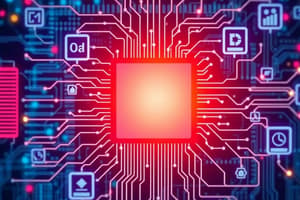Podcast
Questions and Answers
What is the primary difference between data and information?
What is the primary difference between data and information?
- Data is processed and organized, while information is raw facts.
- Information is raw facts, whereas data is processed and organized. (correct)
- Information and data are fundamentally the same with no differences.
- Data is valuable, while information is meaningless without context.
Which of the following technologies was NOT invented in the 1800s?
Which of the following technologies was NOT invented in the 1800s?
- Telephone
- Early computers
- Telegraph
- Email (correct)
Which of the following best describes the term 'ICT'?
Which of the following best describes the term 'ICT'?
- Tools exclusively for storing data.
- Technologies that provide access to information through telecommunications. (correct)
- Only hardware related to computing devices.
- Applications designed solely for digital marketing.
What significant development occurred in the 1960s that laid the groundwork for the internet?
What significant development occurred in the 1960s that laid the groundwork for the internet?
Which of the following options correctly identifies a hallmark of the technological advancements in the 2010s?
Which of the following options correctly identifies a hallmark of the technological advancements in the 2010s?
Which invention is associated with Samuel Morse?
Which invention is associated with Samuel Morse?
What technological advancement made significant strides during the 2000s?
What technological advancement made significant strides during the 2000s?
Which of the following is NOT a component of ICT?
Which of the following is NOT a component of ICT?
What is one way ICT has transformed job opportunities?
What is one way ICT has transformed job opportunities?
Which of the following is NOT considered a benefit of ICT in education?
Which of the following is NOT considered a benefit of ICT in education?
How has ICT impacted socializing?
How has ICT impacted socializing?
Which benefit of ICT specifically addresses access to information?
Which benefit of ICT specifically addresses access to information?
Which tool is mentioned as a new opportunity provided by ICT?
Which tool is mentioned as a new opportunity provided by ICT?
What is a notable economic impact of ICT mentioned in the content?
What is a notable economic impact of ICT mentioned in the content?
What is a security advantage of utilizing ICT?
What is a security advantage of utilizing ICT?
Which term best describes the new economy facilitated by ICT?
Which term best describes the new economy facilitated by ICT?
In which area does ICT not primarily enhance user experience?
In which area does ICT not primarily enhance user experience?
How does ICT contribute to better communication?
How does ICT contribute to better communication?
Flashcards are hidden until you start studying
Study Notes
Uses of ICT in Our Daily Lives
- ICT redefines communication, offering instant and global connectivity through platforms like instant messaging, emails, and video calls.
- Job opportunities are transformed via online recruitment platforms and remote work options, fostering flexibility and access to diverse employment.
- Education benefits significantly from ICT with e-learning platforms that provide flexibility and virtual classrooms that enhance interactive learning experiences.
- Socializing is elevated through social media creating virtual spaces for global interaction and community building, allowing for real-time sharing and engagement.
Impact of ICT in Society
- Enhanced access to information and services due to booming internet growth, enabling cheaper communication methods like VoIP and instant messaging.
- Distance learning and online tutorials facilitate improved educational access, introducing interactive multimedia and virtual reality.
- Availability of innovative tools such as digital cameras, photo-editing software, and high-quality printers that support various user needs, including assistive technologies for those with visual impairments.
- Communication cost savings through alternatives like VoIP for calls, email instead of traditional mail, and video conferencing negating travel costs.
- Access to broader and global markets through e-commerce platforms, improving business opportunities.
- Effective information management, including data mining for targeted advertising and enhanced stock control that minimizes waste and boosts cash flow.
- Security enhancements via ICT, with encryption methods ensuring data safety from unauthorized access.
Introduction to Information and Communication Technology (ICT)
- Data consists of raw, unprocessed facts requiring context to be meaningful, while information is processed, organized data that adds value.
- ICT involves technologies that provide information access through telecommunications, covering hardware, software, networks, and services for data management.
- Key examples of ICT include computers, smartphones, the Internet, and various digital communication tools like email and video conferencing.
Historical Milestones in ICT
- 1837: Telegraph patented by Samuel Morse initiates long-distance communication.
- 1876: Alexander Graham Bell’s invention of the telephone further revolutionizes communication.
- 1940s-1950s: Early computers like ENIAC and UNIVAC emerge.
- 1960s: ARPANET, the internet’s precursor, is developed.
- 1970s: Email and the TCP/IP protocol are established.
- 1980s: Personal computers achieve widespread adoption.
- 1990s: The World Wide Web is launched by Tim Berners-Lee.
- 2000s: Emergence of social media platforms like Facebook and Twitter.
- 2010s: Smartphones and mobile computing proliferate.
- Present: Ongoing advancements in AI, cloud computing, and the Internet of Things (IoT) expand the scope of ICT.
Data vs Information
- Data: Raw, unprocessed facts that require context to become useful.
- Information: Processed, organized, and interpreted data that adds meaning and value.
Introduction to ICT
- Definition: ICT refers to technologies providing access to information via telecommunications, including hardware, software, networks, and services for data storage, retrieval, and communication.
- Examples: Computers, smartphones, the Internet, social media, email, and video conferencing.
History of ICT
- 1837: Telegraph invented by Samuel Morse, initiating long-distance communication.
- 1876: Alexander Graham Bell invents the telephone, enhancing communication.
- 1940s-1950s: Development of early computers such as ENIAC and UNIVAC.
- 1960s: Creation of ARPANET, the internet's precursor.
- 1970s: Development of email and the TCP/IP protocol.
- 1980s: Widespread use of personal computers.
- 1990s: Tim Berners-Lee creates the World Wide Web.
- 2000s: Emergence of social media platforms like Facebook and Twitter.
- 2010s: Surge in smartphone and mobile computing adoption.
- Present: Advancements in artificial intelligence, cloud computing, and the Internet of Things (IoT).
Uses of ICT in Daily Life
- Communication: Provides instant and global connectivity through messaging, emails, and video calls.
- Job Opportunities: Introduces online recruitment platforms and remote work, enabling access to job opportunities from anywhere.
- Education: Revolutionizes learning through e-learning platforms and virtual classrooms, enhancing accessibility and engagement.
- Socializing: Creates virtual spaces for interaction and connection via social media and online events.
Impact of ICT on Society
- Access to Information: Increased access to services, resulting in better and often cheaper communication methods (e.g., VoIP, Instant Messaging).
- Education: Facilitates distance learning and interactive multimedia experiences, improving learning efficacy.
- New Tools: Provides tools like digital cameras, photo-editing software, and accessibility software for those with disabilities.
- Cost Savings: Reduces communication costs (e.g., VoIP vs. traditional phone) and enhances efficiency through e-commerce.
- Market Access: Expands communication and commerce to larger, even global markets.
- Information Management: Enhances data mining for targeted advertising and improves stock control, reducing waste.
- Security Solutions: Utilizes encryption techniques to safeguard data from unauthorized access.
Studying That Suits You
Use AI to generate personalized quizzes and flashcards to suit your learning preferences.




